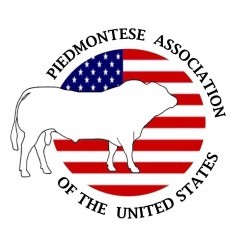Piemontese cattle have a very antique origin. From archaeological findings, rock inscriptions
and fossil remnants the antique history of the breed has been traced back.
These findings indicate as its ancestor a cattle breed of the Aurochs type,
which already in the Pleistocene - and therefore before in other regions of the
Euro-Asiatic continent domestication started - populated the whole Piedmontese
area, where on one side the mountains and on the other vast lake and marshy
zones represented a kind of natural barrier.
In the period
between the medium and superior Palaeolithic, about 25 000-30 000 years ago,
another ethnic group penetrated massively into the Piemontese territory and
mixed with the pre-existent one, forming a new breed that showed the clear
characteristics of the present Piemontese.
This breed was
the Zebu, which originated in West-Pakistan. The reason for this rapid
migration into various sectors of the European continent is still unknown. The
migratory wave finished its journey in the Piedmontese 'trap': the Alps blocked
the way and staying became inevitable.
Gradually the Aurochs
and the Zebu population mixed and formed over time the Piemontese cattle breed.
The National Association of Piemontese Cattle Breeders ANABORAPI (
www.anaborapi.it) was founded in 1960 with the aim to
develop the breed and its genetic improvement. The Association establishes the
selection criteria, keeps a Herd-book and runs a Genetic Station where
performance tests and progeny tests are carried out. It also runs an Artificial
Insemination Station where semen from A.I. bulls is produced.
It has very fine
bones, a fine and elastic skin, a low quantity of external fat and lean and
tender, but tasty meat.
The bulls have a
grey or pale fawn coat, with black hairs on the head (especially around the eye
sockets), on the neck, the shoulders, the distal regions of the limbs and
sometimes on the lateral faces of the body and the hind limbs. The cows have a
white or pale fawn coat with shades of grey or pale fawn. At birth the coat of
the calves is of a deep pale fawn colour. The tongue, the palate and the
external mucosae are black.
The cows are of a medium size (550 - 600 kg), at birth the calves weigh on
average from 40 to 45 kg. The male fattening calves are ready for slaughtering
at a weight of 550-650 kg when they are about 15 -18 month old, the females at
about 350-450 kg when they are about 14-16 months old.
Notwithstanding
their size, the weight gain of Piemontese cattle is high, reaching 1.4 kg a day
in the calves between weaning and slaughtering, when feeding and environmental
conditions are optimal. The indices of the food conversion are extremely high
and confer to the Piemontese a feeding efficiency which is definitely superior
to all the other beef breeds.
The dressing out
percentage is very high, on average 67-68% in the fattening calves, with peaks
of 72%, thanks to the extremely fine bones and the low quantity of external
fat. The conformation of the carcasses is excellent: they are always classified
S and E of the S-EUROP classification.
The milk
production of the Piemontese is sufficient to suckle the calf; this as a
consequence of the double-purpose selection applied on the breed in the past.
Some of the Piemontese breeders use the milk for cheese production. The cheeses
"Castelmagno", "Bra", "Raschera" and many of the
"Tome" coming from the valleys of the region Piemonte are produced
with Piemontese milk.
The particular
characteristic of the Piemontese cattle breed is the muscular hypertrophy,
better known as the 'double muscle factor'. The double muscle factor appeared
at the beginning of last century and spread progressively over the breed up to
a point in which nearly all the Herd-book animals possess this characteristic
and a very high percentage of the breed as a whole.
The Piemontese is
a long-living breed that adapts very well to many different climates and that
can be bred as easily in a confined rearing system as in an open herding or a
semi-open herding system. The Piemontese cow can be bred favourably not only on
plane and hill pastures but also on mountain pastures. The breed has an
excellent food conversion and adapts to the most diverse environmental
conditions.
Content and photo source: Agraria.org

